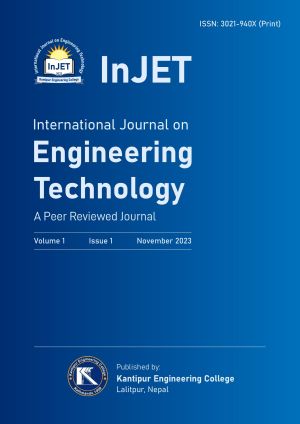Feasibility Study of a Motorcycle Lane: Evaluation of Travel Time and Delay Impacts at New Baneshwor Intersection
DOI:
https://doi.org/10.3126/injet.v1i1.60905Keywords:
Intersection, Motocycle Lane, VISSIM, PTW, Urban MobilityAbstract
Like many South Asian countries, Nepal can be identified as a “Motorcycle Dependent Country” as the chief mode of transportation on the urban streets of Nepal compromises of Motorcycles for their daily commute. With inefficient public transportation, haphazard lane discipline, and easy accessibility and mobility of PTW, there is a rising dependence on PTW. The risk of life that comes with this dependence is also increasing in the urban streets of the country. Therefore, this research proposes Motorcycle Lanes as a measure to reduce congestion and create a risk-free riding environment. Three scenarios– a) Considering Dedicated motorcycle lanes b) Excluding right turning traffic into dedicated motorcycle lanes c) Dedicated motorcycle lanes only for two intersection legs Maitighar-Tinkune and Tinkune-Maitighar have been proposed, analyzed and compared with base data to measure the efficiency of motorcycle lanes at the New-Baneshwor intersection. The feasibility of those scenarios was checked based on traffic volume, Q-length, and vehicle delay with base data obtained from simulation in VISSIM. It was observed that difficult turning movements, unpredictable riding behavior and signal phases rendered the lanes unfeasible. A need for a holistic approach to address current and future traffic conditions as PTW are poised to experience a high upswing in foreseeable future is an essence.
Downloads
Downloads
Published
How to Cite
Issue
Section
License
This license enables reusers to distribute, remix, adapt, and build upon the material in any medium or format, so long as attribution is given to the creator. The license allows for commercial use.




